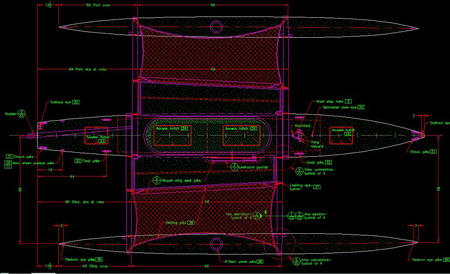|
|
The Tridarka Raider
A Trimaran for Coastal Vagabonds
Deck Plan
|

|
This sketch shows the Tridarka Raider deck plan in full cruising dress. Some of
the items shown might be left at home when racing.
The center cockpit is self bailing with a floor above the waterline.
Notice the two access hatches to reach storage areas underneath. These storage
areas are intended for heavy items like water, food, batteries, spare anchors, and
so on. The hatches are waterproof and strong enough to walk on. Even
so I'd recommend waterproof bags or boxes be used for any items that must stay dry.
The cockpit is intended to be comfortable for two and luxurious for 1.
Not shown on this drawing is a canvas dodger that is convertable
to an enclosed cabin.
The cockpit is uncluttered by using a leeboard instead of a centerboard.
I've used leeboards on a few sailing kayaks, sailing canoes, and my Sea Pearl.
I also have had centerboard boats and fin keel boats. There are pros and cons
to each type of lateral resistance device. For a small boat with a narrow
hull room inside the cockpit is at a premium. The leeboard approach is the
right choice for this boat in my opinion.
The hiking benches on each side are optional, but I learned how
useful they can be when I added them to Wango Tango (a previous sailing kayak/trimaran).
They allow comfortable seating and, in some conditions, you can balance the boat
such that the leeward ama is just skimming the water which allows greater speed.
It would be a hard choice whether to leave them home or take them along for the
Ultimate Florida Challenge. The current design uses wood, but it would be
possible to make the hiking benches from dense fabric.
Outboard of the hiking benches you see some additional deck netting.
These nets are as open as possible while still allowing a person to walk comfortably.
I'd remove them for really rough conditions and possibly for racing. They
are very useful for cruising, fishing, diving, and even camping.
Notice that the akas are asymmetric. This allows one ama
to be moved inboard when the overall beam needs to be reduced (CP1 for example).
The akas are hollow box beams to save weight. Also, the akas are lashed to
the vaka and the amas. I had lots of experience with mechanical connections
on Wango Tango. Although mechanical connections worked, I found lashing to
be faster and easier to maintain. I was very happy when I converted Wango
Tango to lashing and decided to keep that system for the Tridarka Raider.
The amas are skinny enough to be fast but have enough bouyancy
to allow me to stand on the ama without it sinking. This is more important
than it might seem at first. Also, these amas are tough. They will have
a Kevlar skin with a doubling at the keel. Three bulkheads will assure that
an ama will be useful even if it hits a submerged object at high speeds.
There are hatches fore and aft for access to storage areas for
light weight gear.
|
|
Adventure Races
for Sailing Small Boats:
WaterTribe Everglades Challenge
WaterTribe Ultimate Florida Challenge
WaterTribe North Carolina Challenge
|